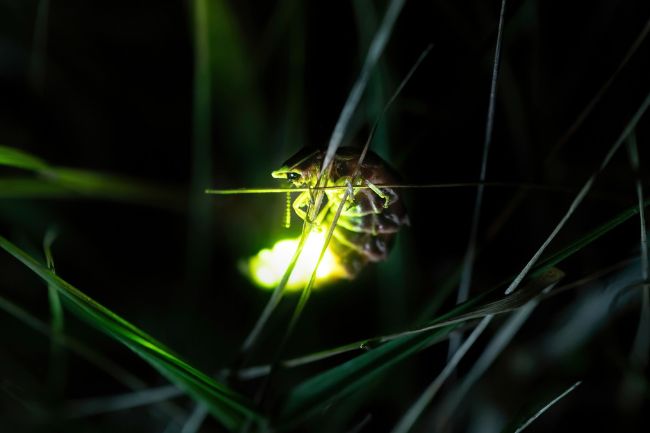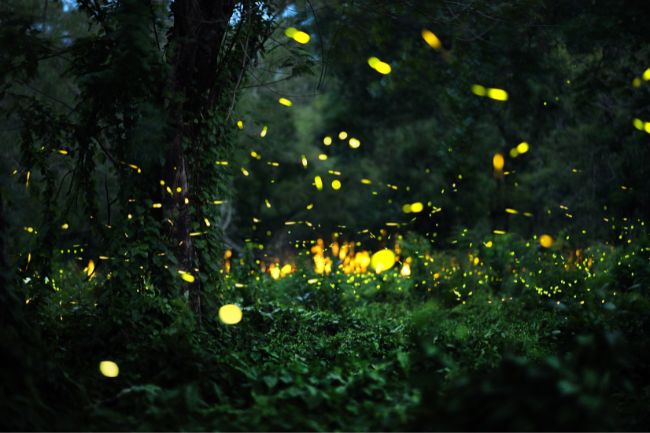Fireflies produce light within an area of their abdomen known as the ‘lantern’. Here, a chemical reaction takes place by adding oxygen to the already present calcium, adenosine triphosphate (ATP) and luciferase enzyme.
Contents
What is bioluminescence?

Bioluminescence is the ability of living creatures to create light through a chemical reaction. While it may seem like something out of a science fiction film, bioluminescence is surprisingly common in the natural world. Wide-ranging groups are able to carry out this magic trick, from fungi to bacteria, to fish and insects.
In most cases, the ability to create light has evolved either as a form of self-dense or as a lure to bring in unsuspecting prey. In deep water fish, lighting up can often be a good way to announce to the world that a larger predator is trying to eat you. This signals to even larger predators that they can come to get an easy meal, thus scaring off the attacker.
In foxfire fungi, it’s thought the glow is designed to attract in insects, which can then spread the fungi’s spores further afield. There are still many species that we don’t know why they choose to glow, sometimes this may be an accident of evolution, while in others it may simply be that we haven’t figured out the light’s usefulness yet.
Bioluminescent light comes in a variety of colours, from blue to yellow, even to orange. The light level also varies, with it sometimes being barely bright enough to see, while at other times it’s a startling intensity.
Yet, whatever its use and whatever creatures produce it, these mysterious lights have long been a fascination for humans, bringing about folk tales and traditions across the world.
What makes fireflies glow?

Bioluminescence is created through a chemical reaction. The precise chemicals used vary across the animal and plant kingdom; however, the mixture used by fireflies is a fairly common combination.
Luciferase, a type of light-producing enzyme, is the key ingredient for a firefly’s glow. The majority of fireflies acquire these enzymes naturally through their diet, however, in some species they have to eat other fireflies in order to stock up on this important ingredient.
Luciferase contain the chemical luciferin, which is how they are able to glow. Along with this vital component, fireflies use adenosine triphosphate (ATP), which was once thought to be solely responsible for the light they produced. The final ingredient to the equation is usually calcium.
| Firefly Species | Bioluminescent Signal |
|---|---|
| Photinus pyralis | Intermittent yellow-green glow |
| Photuris lucicrescens | Continuous yellow-green glow |
| Lampyris noctiluca | Intermittent yellow glow |
| Pyractomena angulata | Intermittent green glow |
For the chemical reaction to occur, oxygen needs to be added to the rest of these ingredients, and this is how fireflies are so carefully able to manipulate their glow. Being able to control when they glow is particularly important for adult fireflies, as the timing of their light displays tells potential mates what species of firefly they are.
The part of the firefly’s body where this chemical reaction takes place is known as the ‘lantern’ and consists of the last few segments on the abdomen. Within the lantern are a series of branching tubes, within which sit photocytes, cells that help the chemical reaction to take place.

Oxygen control was long a puzzle to scientists, as insects have a much more passive way of bringing oxygen into their bodies than mammals. While mammals have lungs that allow them to pull in oxygen, and circulate it to their organs, insects allow air pressure to bring oxygen in via tubes known as trachea.
The oxygen, therefore, moves more slowly through the insect’s body and is more difficult to control. This should mean a quick delivery of oxygen to the lantern, to cause flashes of light, would be impossible.
However, scientists have recently found the trick by which fireflies free up oxygen. They use nitrous oxide, releasing it within their bodies. Nitrous oxygen causes the mitochondria to no longer be able to absorb oxygen. Oxygen then builds up within the lantern, causing it to glow. Turning off nitrous oxygen production then causes oxygen levels to drop and the light goes out.
Also read: Firefly Larvae: Do They Glow, How do They Live & More
Why do fireflies light up at night?
Fireflies use their glow for a number of different reasons. The main one is to advertise that they are unpleasant to eat. Fireflies use their glow as a kind of warning colouration. This tells predators that the fireflies contain toxic chemicals that will make them feel unwell if they eat them.
However, while this is probably why fireflies evolved the ability to glow, adults also use this skill to help find a mate. Different fireflies produce glows in different sequences, colours and lengths, using this key to identify each other.
It’s this ability that gives us the wonderful mating displays that fireflies produce all over the world, with coloured lights all around in woodlands, ponds and meadows.
Not all fireflies play by the rules, however. Some predatory species use their glow to attract in other fireflies in order to devour them. The female firefly of the Photuris species copies the signals of the females of other species, enticing the male to visit her, and then eating them.
| Bioluminescent Behavior | Purpose |
|---|---|
| Mating flashes | Attracting mates and signaling reproductive readiness |
| Flash synchronization | Coordination among fireflies for mating |
| Warning flashes | Signaling unpalatability or toxicity |
| Species-specific flash patterns | Recognition and species identification |
Why fireflies glow at night is probably due to the fact that their light will be most visible at night, and therefore will be more easily seen and effective at this time. Why glow in the day, when that glow is lost in the sunlight? Fireflies are also most active at night, meaning this is the best time for them to interact with other fireflies.
Also read: What Eats Fireflies? (Its Natural Predators)
No business like glow business
Bioluminescence is no doubt one of nature’s greatest wonders, and fireflies are some of its most accomplished masters. From those that glow continuously, to others that carry out impressive sequences, they never cease to amaze in their displays, both for love and defence.
Today humans are more interested than ever in a creature’s ability to create light, a science we replicate for our own purposes, from medical applications to engineering. Yet, even with all our studies the secrets of a firefly’s light, are only now being unravelled, with much more besides to be discovered.

